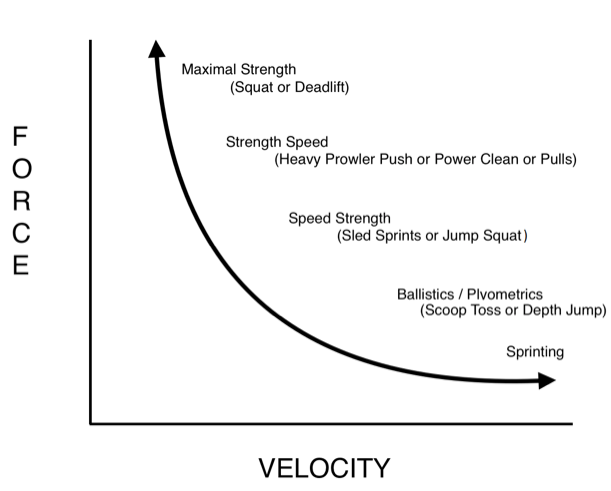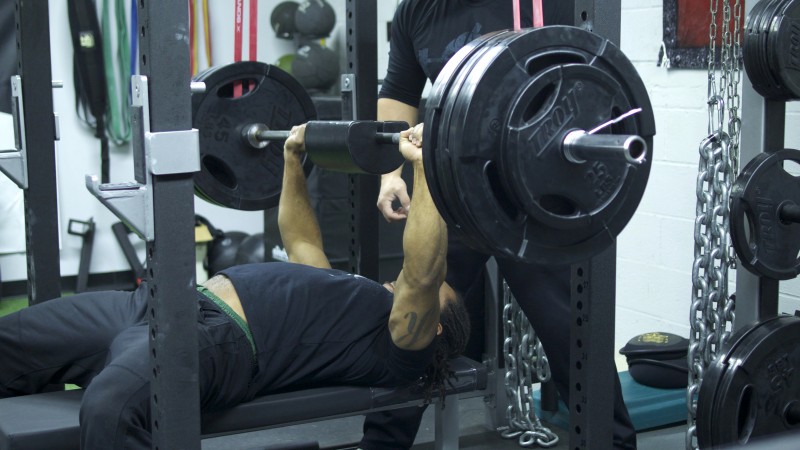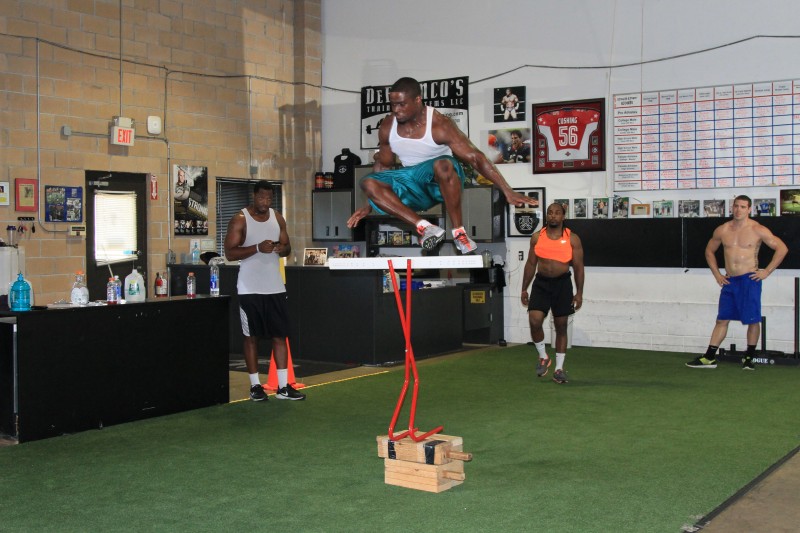
In part one of this series, I discussed a brief overview of maximum strength training for team sport athletes. In this section, I will provide a case in support of training for power development. As explained in part one, power is the combination of force and velocity (strength and speed). Force efforts displayed in sport movements require different levels of strength, speed, and power. This is primarily based on the amount of strength required to produce the movement and the time frame available to accomplish the task.
Part 1: Should I Lift or Should I Sprint — The Case for Strength
Some athletes must overcome the resistance of an opponent in an explosive manner (i.e. American football offensive lineman or rugby scrum) while others have to perform explosive movements against the resistance of their own body weight in actions such as jumping, changing direction, or sprinting.
Power = Force x Velocity
One of the most important principles to understand is that there is an inverse relationship between force and velocity. As force increases, velocity decreases and vice versa. This can be easily understood when considering a 1-rep maximum lift versus lifting the bar by itself. The speed during a squat 1-rep maximum will be drastically slower than an unloaded barbell squat if both are performed with the intention of fast bar movement. The highest forces occur when loads are the heaviest, the highest velocities are achieved when loads are the lightest, and everything else falls in between. This relationship can be depicted by looking at the force-velocity curve presented below. 
The Force-Velocity Curve
The amount of resistance to overcome will always fall somewhere along the force-velocity curve. This is where categories of motor abilities have been created to help give us a better understanding of what exactly we are training. A brief list of different categorizations of motor abilities is provided below (1, 11, 18, 19):
- Maximum Strength — Ability to apply maximum levels of force with no time constraint
- Relative Strength — Ability to apply maximum levels of force relative to the athlete’s body mass
- Explosive Strength* — Ability to overcome heavy resistances with speed
- Acceleration Strength* — Ability to rapidly build up force once the movement as been initiated
- Strength-Speed* — Ability to overcome moderate resistances with high speeds
- Speed-Strength* — Ability to overcome light resistances with high speeds
- Starting Strength* — Ability to rapidly execute movement and produce force from a stand-still
- Strength Endurance — Ability to apply certain levels of force for prolonged periods of time
The strength categorizations that have an asterisk (*) are, in reality, an expression of power due to the fact that there is a speed component involved (1). As “strength” typically refers to force without necessarily referring to any velocity or time constraint, the categorizations that involve higher velocities imply that they are stressing more power-dominant qualities rather than pure strength or force development.
The Rate of Force Development
As we can see from the examples presented above, motor qualities like explosive strength, acceleration strength, or speed-strength require that force be built up as rapidly as possible. Attempting to produce force quickly is the premise behind the rate of force development (RFD). The RFD observes how quickly force can be produced in a given task.
In the literature, velocity is commonly reported using meters per second (m/s) and we can use this unit to paint a clearer picture of RFD. Let’s say a person performed a 50-meter sprint. How many meters did they cover per second of that sprint? Knowledge of the sprint velocity (m/s) provides a clue of how fast the person is capable of moving while sprinting. The same form of measurement can be applied to the speed of any movement.
It is very common now for researchers to look at speed of jumps, throws, and lifting weights using meters per second to understand the rate at which these movements are occurring. Velocity-based training (VBT) has emerged as a way to quantify this type of work by measuring the velocity of the movement. In the case of lifting weights, the ultimate goal is to move greater loads at greater velocities (m/s).
Velocity-Based Strength Training
Let’s look at an example of how velocity-based training can give us insight into the RFD of lifting exercises. Two athletes (Athlete A and Athlete B) are both capable of squatting at least 315 pounds. The bar is loaded with 315 pounds and both athletes are told to lower the bar under control and then drive the bar back up as fast as they can while maintaining form and control (dynamic effort method). A device capable of measuring the bar velocity is used during the experiment. The results are as follows:
Athlete A: 315 pounds @ 0.74 m/s
Athlete B: 315 pounds @ 0.34 m/s
In this example, both athletes successfully completed a repetition at 315 pounds but Athlete A moved the bar much faster than Athlete B. So even though they were both capable of squatting the weight, Athlete A was able to generate a better RFD. It could be concluded that Athlete A produced more power in the same squat exercise and has more power potential than Athlete B.
There are multiple devices nowadays that can be used to measure bar velocity and the right choice is dependent upon how the coach wishes to use them and what is willing to be spent — anywhere from $200-$2000.
Relative Strength Influences Power Output
It’s easy to understand that moving heavy weight with more speed can result in more power. But recall that the SAID principle states that specific adaptations will result from imposed demands. Therefore, power should be developed against heavy, moderate, and light loads to improve across the board. It should also be remembered that the more maximum strength one possesses, the more force one is able to produce against any form of load (heavy, light, etc.) which will consequently influence power potential.
Consider the vertical jump, which is a test of maximum power ability. A person’s body weight (in addition to gravity and other constant forces) will determine the load that must be overcome. The force that needs to be generated must be great enough to overcome the person’s own body weight and the velocity must be high enough to propel the body into the air. Recent research has depicted a positive correlation between takeoff velocity in the vertical jump and the height attained. Since reducing the load of resistance will result in greater velocity potential, it can easily be argued that the more maximum strength one possesses relative to one’s body mass (relative strength), the lighter the overall load will be in the vertical jump. In this case, one would be capable of producing a higher velocity at takeoff, resulting in a higher vertical jump.
WATCH: The CVASP Podcast — How to Use Vertical Jump Data
It becomes clear that maximum strength (especially relative strength) is only a part of the equation when it comes to power output, but a vital part nonetheless. Higher levels of relative strength will allow the potential for any unloaded movements to be performed with more velocity, which is paramount in jumping, sprinting, or any other explosive activities involving just the athlete’s bodyweight.
Power Specificity
Although strength is an important part of the process in power development, increasing levels of strength will eventually lead to diminishing returns in gains of power. As the SAID principle implies, in order to achieve further gains in power output, specific power exercises must be used in training. This does not mean that strength training should be completely removed from the training process. Removing maximum strength training entirely from a training program is likely to negatively affect the overall power potential and strength training should remain an integral part of the training process to maintain force production capabilities while higher volumes can shift towards purely explosive, maximum power exercises (1, 12).
Common exercises used to develop maximum power output are:
Jump Training:
Jump training entails different forms of jumps that are intended for maximum height or maximum distance. Jump training can also include weighted jump exercises like barbell squat jumps or jumps while holding dumbbells or kettlebells.
Plyometric Training:
Plyometric exercises are characterized by a rapid, high-intensity eccentric contraction and an immediate, rapid, and powerful concentric contraction (10). Plyometric training takes advantage of the stretch-shortening cycle (SSC), which relies on forced involuntary stretching of the muscles and tendons to build up free energy that can be utilized in the subsequent muscle contraction after the stretch (20).
NOTE: It is important to make the distinction between plyometric training and jump training: in jump training, there can be relatively long periods of time taken to execute the movement (such as the time taken to dip and jump in a vertical jump), whereas plyometric exercises are executed as quickly as possible. The time taken to perform plyometric exercises can be as quick as 0.15-0.20 seconds! Jump training and plyometric training both utilize the SSC but the primary difference between them is that plyometric exercises exert much faster rates of movement than jump training. While all jump exercises would fall under the category of jump training, not all forms of jumps can be considered plyometric exercises.
Ballistic Training:
Ballistic exercises are commonly described as explosive movements in which the body or an object is launched into free space. Jump training and plyometric training can both be considered forms of ballistic training. Explosive throwing exercises like medicine ball throw variations are also ballistic. Throwing exercises preceded by a rapid stretch can also fall under the plyometric training category. An example would be having a partner drop a medicine ball from a predetermined height and attempting to catch and immediately throw the ball in a given direction upon impact. Other common forms of ballistic exercises include barbell squat jumps and bench press throws in a smith rack.
Short Sprints and Resisted Sprinting:
Sprinting is commonly understood as a way of developing acceleration and speed but sprints that are shorter in duration (10-30 meters or yards) and sprints performed against resistance require higher force development than maximum velocity sprinting. This environment is great for developing power with higher velocities than any lifting, jumping or throwing exercise.
Olympic Weightlifting:
While Olympic weightlifting is a sport within itself, the snatch and the clean and jerk (along with their derivatives and variations) provide a unique training stimulus in which high loads of resistance can be moved at velocities that are higher than other barbell lifts like the squat or deadlift. If you cannot move the bar with enough speed in an Olympic lift, you will not be successful in completing the lift. This sets up potential for high power outputs against a substantial amount of resistance. For sports in which high resistances are present and must be handled with high power (such as blocking for an American football lineman or takedown movements for a wrestler/MMA fighter), the Olympic lifts can add a lot of value.
Compensatory Acceleration Training or Dynamic Effort Method:
Although the Olympic lifts are great at producing large amounts of power against a lot of resistance, they require a lot of technique and coordination. It can take several years to achieve proficient execution of the snatch and clean and jerk. An alternative option that still allows for larger loads to be moved explosively is to incorporate compensatory acceleration training (CAT), also known as the dynamic effort method (DE). This form of training falls in line with velocity-based training in which fundamental resistance exercises like the barbell squat or deadlift are performed with the intent of moving the bar as quickly as possible in the concentric portion of the lift. While the same load may not move as quickly as it would for an Olympic lift, CAT and DE still provide a similar training stimulus in which power is being generated against higher loads of resistance. The use of velocity measurement devices can paint a very clear picture of the actual bar speed but typically the recommendations for using CAT and DE are to use loads of 50-75% 1RM with 1-3 reps per set for anywhere from 6-12 total sets (13). The low reps allow for power output to remain high on each rep so that the bar speed does not slow down significantly.
NOTE: When using CAT, DE, and VBT it is paramount to ensure that quality of lifting is not sacrificed in favor of achieving higher movement speeds. The faster velocity of lifting will only be beneficial if the exercise form remains intact. Quality training must be ensured above all else!
Power Training Variation
By looking at the force-velocity curve, we can see how different power training means might fit along the continuum between force and velocity. Like anything else, the development of power is specific and only focusing on one end of the force-velocity continuum may heed initial positive results but will ultimately limit your overall power potential. Therefore, regardless of your sport, it is important to at least spend SOME time focusing on all of these areas. The sport being played will determine just how much time and volume should be spent on certain areas versus others.
Now that we have provided a case for maximum strength training and power training, the next step is to provide a case for speed training. In part three, I will overview the current consensus in regards to sprint training and how improving acceleration and maximum velocity capabilities affect advancements in athletic ability.
References
- Baker D. Using Strength Platforms for Explosive Performance. In: Joyce D, Lewindon D, editors. High Performance Training for Sports. Champaign (IL): Human Kinetics; 2014. p. 127-144.
- Cormie P, McGuigan MR, Newton RU. Adaptations in athletic performance after ballistic power versus strength training. Med Sci Sports Exerc. 2010;42(8):1582-98.
- Dietz C, Peterson B. Triphasic training: A systematic approach to elite speed and explosive strength performance. Bye Dietz Sport Enterprise; 2012.
- Francis C, Patterson P. The Charlie Francis Training System. TBLI Publications; 1992.
- Hansen D. Successfully Translating Strength Into Speed. In: Joyce D, Lewindon D, editors. High Performance Training for Sports. Champaign (IL): Human Kinetics; 2014. p. 145-166.
- Jeffreys I. Gamespeed: Movement training for superior sports performance. Monterey (CA): Coaches Choice; 2010.
- Jeffreys I, Moody J, editors. Strength and Conditioning for Sports Performance. New York (NY):Routledge; 2016.
- Kraaijenhof H. Muscle Fiber Specific Training. In: Thome M, DeMayo J, White A, editors. Central Virginia Sport Performance: The Manual (Vol. 1). Richmond (VA): Central Virginia Sports Performance; 2016.
- Kraaijenhof H. What We Need Is Speed: Scientific Practice of Getting Fast. Ultimate Athlete Concepts; 2016.
- Mann B. Velocity-Based Training In Season. In: Thome M, DeMayo J, White A, editors. Central Virginia Sport Performance: The Manual (Vol. 1). Richmond (VA): Central Virginia Sports Performance; 2016.
- Markovic G. Does plyometric training improve vertical jump height? A meta-analytical review. British J Sports Med. 2007;41(6):349-55.
- Newton RU, Rogers RA, Volek JS, Häkkinen K, Kraemer WJ. Four weeks of optimal load ballistic resistance training at the end of season attenuates declining jump performance of women volleyball players. J Strength Cond Res. 2006;20(4):955-61.
- Simmons L. Westside Barbell Book of Methods. Westside Barbell; 2000.
- Smith J. Applied Sprint Training. James Smith; 2014.
- Stone MH, Cormie P, Lamont H, Stone M. Developing strength and power. In: Jeffreys I, Moody J, editors. Strength and Conditioning for Sports Performance. New York (NY):Routledge; 2016.
- Strength Power Speed Web site [Internet]. British Columbia (CA): Strength Power Speed: High Performance Training; [cited 2016 Oct 23]. Available from: http://www.strengthpowerspeed.com/the-complete-system/
- University of Minnesota Duluth Web site [Internet]. Duluth (MN): University of Minnesota Duluth; [cited 2016 Oct 23]. Available from: http://www.d.umn.edu/~dmillsla/courses/motorlearning/documents/chapter03f2012.pdf
- Verkhoshansky Y, Verkhoshansky N. Special strength training: manual for coaches. Rome (IT): Verkhoshansky; 2011.
- Verkhoshansky Y, Siff MC. Supertraining. 6th ed. Verkhoshansky; 2009.
- Yessis M. Explosive Plyometrics. Ultimate Athlete Concepts; 2009.
Cameron Josse is the Director of Sports Performance for DeFranco's Training Systems in East Rutherford, NJ. Cameron has been working with DeFranco's Training Systems since 2013 and has quickly built up a resume working with a multitude of athletes in high school and collegiate sports, as well as professional athletes from leagues such as the NFL, NHL, UFC, and WWE superstars. Cameron earned his bachelor's degree in kinesiology while playing football at the University of Rhode Island and also holds a master's degree in exercise science from William Paterson University.











